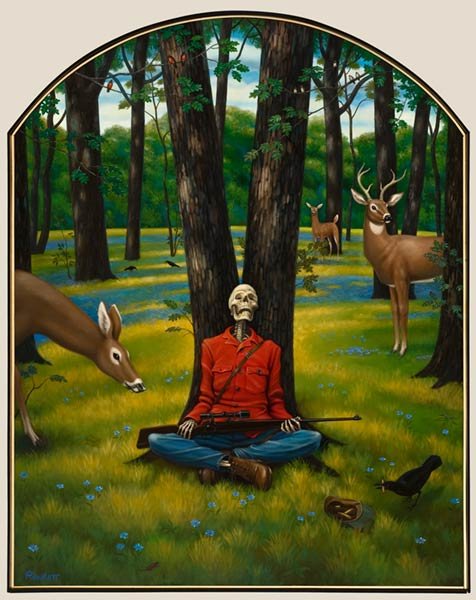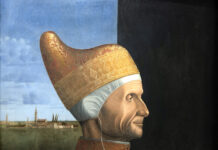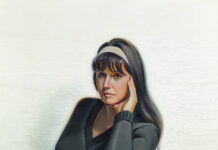To understand Terry Rowlett’s paintings is to take a glimpse into his captivating life journey from evangelical roots in Arkansas to hipster-bohemian Athens, Georgia.
Some art historians have argued that all art production is simply an attempt to visualize and understand that which we cannot: the Divine. Certainly, our earliest creative impulses, found today on the walls of Paleolithic caves in France and Spain, suggest a drive to know the world and the mysteries and creatures contained within it. Artist Terry Rowlett works in this vein, driven by a desire to grasp his own spirituality. Although Rowlett’s Christian faith has been absent for some time, he has found fulfillment in nature, and his paintings explore our connections — or lack thereof — with nature while drawing on Renaissance and Baroque traditions.

Terry Rowlett, “Flight Into Egypt,” 1999, oil on canvas, 60 x 70 in. (c) Terry Rowlett 2015
“My inspirations often arrive as little epiphanies,” writes Rowlett, “epiphanies that usually occur in the landscape.” For Rowlett, a painting often begins when something in nature catches his eye, be that an unusual copse of trees or a rock formation. “Within these moments my mind’s eye sees a phantom character that could inhabit such a place. Sometimes the character comes very clearly, and I know exactly what he or she looks like and what they are doing in this spot. Other times I have to mull over the phantom until I know more certain what this person is trying to say.”
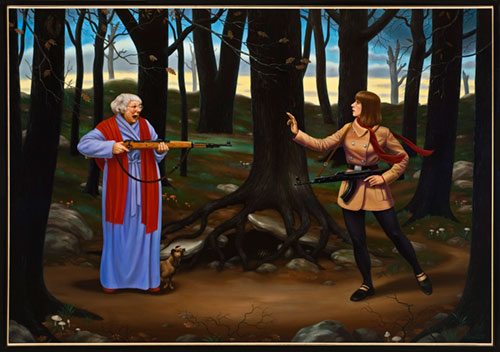
Terry Rowlett, “The Dark Forest,” 2010, oil on canvas, 44 x 63 in. (c) Terry Rowlett 2015
Rowlett’s early work, such as the vibrant “Flight Out of Egypt,” from 1999, is decidedly Christian in theme, but viewed through a modern lens. A middle-class suburban family is seen moving down a sidewalk. Mary, in this case, rides a bicycle, with Christ resting in a seat behind. Joseph, wearing classic “Chucks” and button-up shirt, strolls with a bag of groceries. There is a beautiful graphic quality and strangeness to Rowlett’s work — interesting compositions, vibrant colors, and narrative — that calls the viewer’s attention.
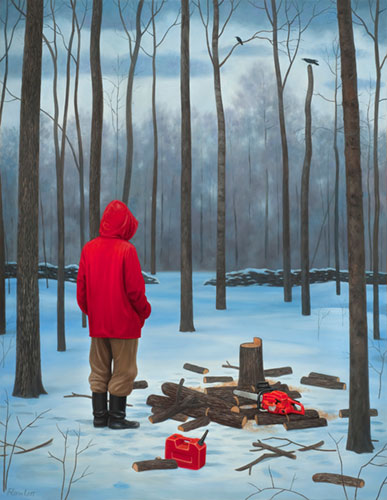
Terry Rowlett, “Stillness of Winter,” 2014, oil on canvas, 47 x 36 in. (c) Terry Rowlett 2015
“The Dark Forest” is a more recent work and again displays strong landscape devices with interesting human characters, though the Christian narrative has given way to a different story. Among a grove of dark, looming trees, an elderly woman dressed in her blue housecoat with a brilliant red scarf, points her rifle toward another, much younger, woman. The young woman is dressed in fashionable, contemporary clothing and holds a more imposing automatic assault rifle. Rowlett writes, “The dark woods were meant to suggest danger, mystery, and the dark night of the soul.” The differences between modern and contemporary, young and old, traditional and avant-garde are seen in the juxtaposition of the two characters.

Terry Rowlett’s Maine studio with “Hermit” series in-progress. (c) Terry Rowlett 2015
“As a young man, I traveled to Italy to study art, and it was there where I found my techniques and format for painting,” the artist writes. “The churches and museums were full of these great paintings that spoke and preached to me these strange and seemingly important messages relating to God, mankind, and nature. I feel as though I’m continuing in this style of communication, minus the Christianity, but still concerning myself with man, nature, God, and their relationship.”
Currently, Rowlett has been working on a new series of paintings concerning hermits in Maine all summer. He is also presently featuring at the Zeitgeist Gallery in Nashville, Tennessee.
To learn more, visit Terry Rowlett.
This article was featured in Fine Art Today, a weekly e-newsletter from Fine Art Connoisseur magazine. To start receiving Fine Art Today for free, click here.

